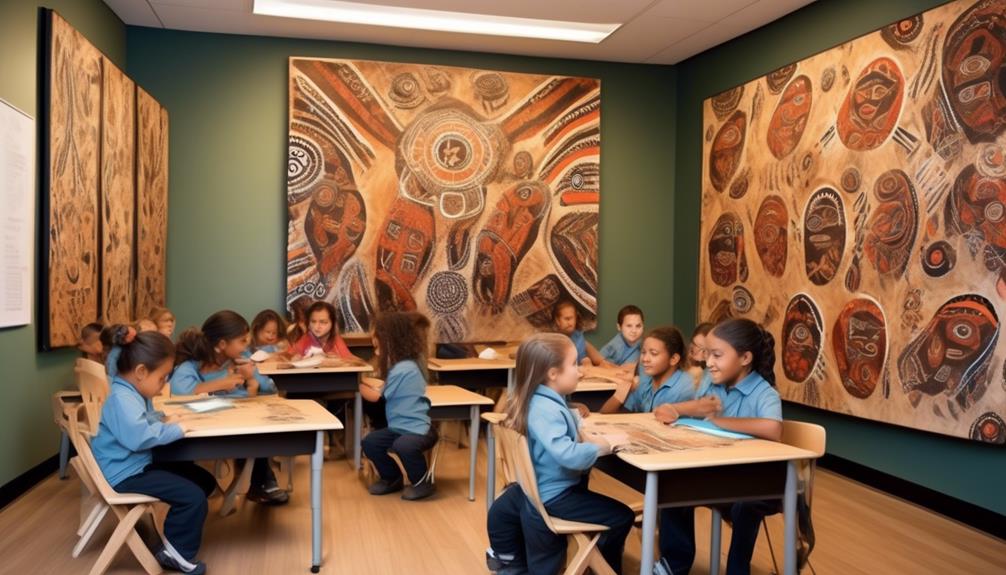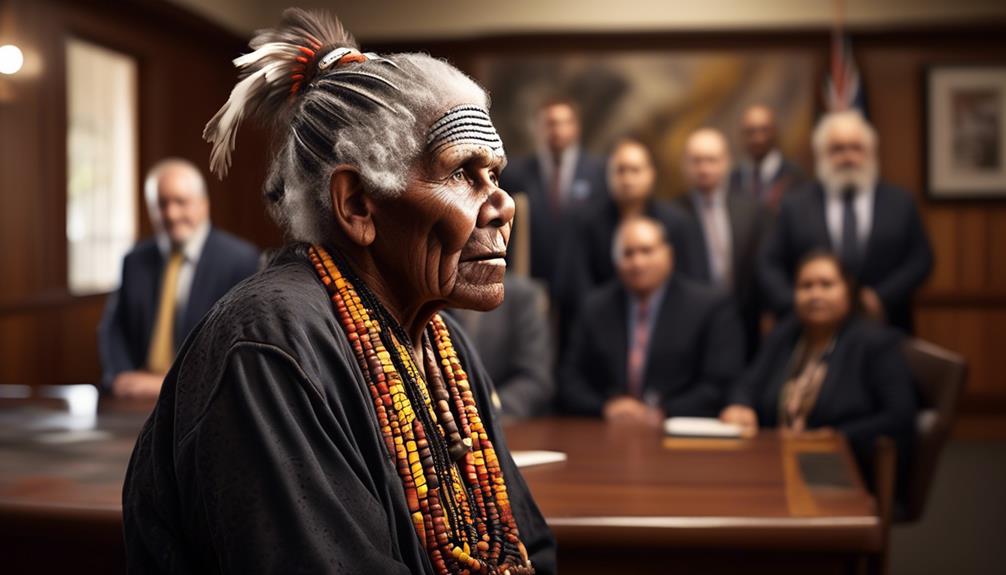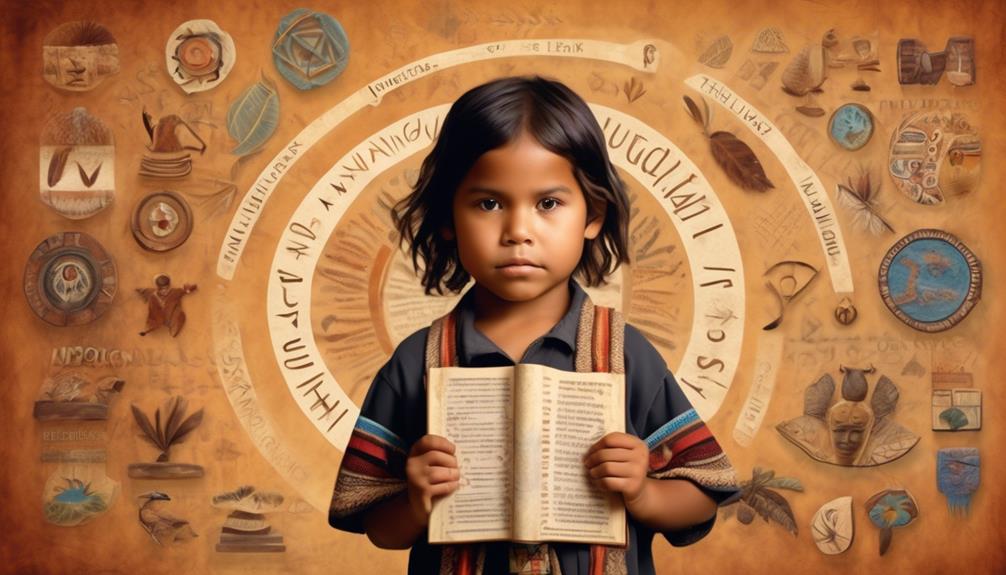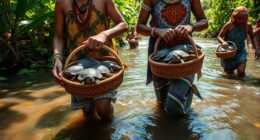Welcome to our article exploring the revitalization of the Narungga language! The Narungga people, who are the indigenous custodians of the Yorke Peninsula in South Australia, have a rich cultural heritage that is closely tied to their language. This article will delve into the importance of preserving indigenous languages like the Narungga language, ongoing efforts to revive it, and the role of technology in supporting this endeavor.
Language is not only a means of communication but also a key aspect of cultural identity. The Narungga language is a vital part of the Narungga community’s heritage, reflecting their unique worldview, traditions, and connection to the land. Unfortunately, like many indigenous languages, the Narungga language faces the threat of extinction.
However, there is hope for its preservation and revival. Through collaborative efforts involving the Narungga community, linguists, educators, and various stakeholders, significant progress has been made in revitalizing the Narungga language. The creation of a Narungga language dictionary, resources, and curriculum focused on Narungga language learning plays a crucial role in these efforts.
By revitalizing the Narungga language, we can ensure the transmission of indigenous knowledge, strengthen cultural resilience, and foster a sense of pride and identity among the Narungga community.
Join us as we delve into the world of Narungga language revitalization and discover the transformative power of language in preserving cultural heritage.
Key Takeaways:
- The Narungga language is an indigenous language spoken by the Narungga people, the traditional owners of the Yorke Peninsula in South Australia.
- Preserving indigenous languages is crucial for maintaining cultural diversity, heritage, and the transmission of indigenous knowledge.
- The Narungga Language Revitalization Project focuses on creating language resources, such as a comprehensive dictionary, curriculum, and learning materials, to ensure the preservation of the Narungga language.
- Collaboration between the Narungga community, linguists, educators, and stakeholders is essential for successful language preservation initiatives.
- Technology plays a significant role in language revitalization efforts, enabling wider access to language learning resources and fostering engagement with the Narungga language.
The Importance of Preserving Indigenous Languages
Preserving indigenous languages, such as the Narungga language, is essential for maintaining cultural diversity and heritage. Indigenous languages hold valuable knowledge about land, culture, traditions, and identity.
As many indigenous languages face the threat of extinction, efforts to preserve and revitalize these languages are vital for the well-being of indigenous communities and the wider acknowledgment of their cultural contributions.
Cultural Diversity and Heritage
Indigenous languages are not just a means of communication but also a gateway to cultural diversity and heritage.
“Language is an important part of our cultural identity. It connects us to our ancestors and helps us understand our place in the world.” – Lena Johnson, Narungga Elder
A Living Repository of Knowledge
Indigenous languages carry centuries of wisdom, traditions, and indigenous knowledge systems.
“Our language holds the keys to our history, our connection to the land, and the wisdom of our ancestors. It is our responsibility to preserve it for future generations.” – David Thompson, Narungga Language Teacher
Promoting Cultural Resilience
Preserving indigenous languages is crucial for fostering cultural resilience and strengthening indigenous communities.
Language revitalization initiatives provide opportunities for community members to reconnect with their roots, build pride in their heritage, and pass down cultural traditions to the younger generations.
Recognition and Inclusion
Revitalizing indigenous languages promotes wider acknowledgment of indigenous cultures and their contributions to society.
By preserving and revitalizing indigenous languages, we ensure that diverse voices and perspectives are heard, respected, and included in the social fabric of our nations.
| Importance of Preserving Indigenous Languages | Impacts |
|---|---|
| Promotes cultural diversity and heritage | Preservation of unique knowledge systems and traditions |
| Fosters cultural resilience | Strengthens indigenous communities and identity |
| Encourages wider recognition and inclusion | Acknowledgment of indigenous contributions to society |
The Narungga Language Revitalization Project
The Narungga Language Revitalization Project is a community-driven initiative dedicated to preserving and revitalizing the Narungga language. Our goal is to ensure the language’s survival and transmission to future generations. Through the creation of Narungga language resources, including a comprehensive dictionary, curriculum, and learning materials, we aim to facilitate Narungga language learning and engage individuals in the process of language revitalization.
By developing Narungga language resources, we provide valuable tools for learners to immerse themselves in the language and deepen their understanding of its grammar, vocabulary, and pronunciation. The comprehensive Narungga language dictionary serves as a reference for both beginners and advanced learners, offering a wealth of information about the language’s structure and usage.
Supporting Narungga Language Learning
The Narungga language curriculum is designed to cater to different learning needs and levels of proficiency. It provides a structured framework for learners to progress systematically, covering essential language skills such as speaking, listening, reading, and writing. The curriculum incorporates culturally relevant content, allowing learners to explore and appreciate the rich cultural heritage embedded in the Narungga language.
Our learning materials are diverse and engaging, including audio recordings, videos, interactive exercises, and storytelling. These resources create an immersive language learning experience that encourages active participation and fosters a deeper connection to the Narungga language and culture.
Language is a vital thread that connects us to our heritage and strengthens our identity. The Narungga Language Revitalization Project offers a pathway for our community to reclaim, revitalize, and celebrate our ancestral language.
Preserving Narungga Language
The Narungga Language Revitalization Project is committed to preserving the Narungga language through various initiatives. We collaborate closely with Narungga language speakers, elders, linguists, and community members to document and record the language’s oral traditions, stories, and songs. These valuable recordings form a lasting repository of the Narungga language, ensuring its preservation for future generations.
In addition to language documentation, we actively engage in community outreach programs, workshops, and events that promote Narungga language learning and create platforms for language practice and cultural exchange. Through these activities, we foster a vibrant and supportive community of language enthusiasts and learners who play an active role in preserving and revitalizing the Narungga language.
Empowering the Narungga Community
The Narungga Language Revitalization Project acknowledges the vital role of the Narungga community in language preservation. We empower community members by providing opportunities for them to contribute their knowledge, stories, and experiences to the project. This collaborative approach ensures that the language revival is guided by the community’s needs, aspirations, and lived experiences.
By revitalizing the Narungga language, we not only preserve a unique linguistic heritage but also empower the Narungga community. Language revitalization enhances cultural pride, fosters intergenerational connection, and contributes to the overall wellbeing of individuals and the community as a whole.
Join us in the Narungga Language Revitalization Project and be part of the journey to preserve and celebrate the Narungga language!
Collaborative Efforts for Language Preservation
In the efforts to preserve the Narungga language, collaboration plays a crucial role in ensuring its success. We bring together the Narungga community, linguists, educators, and other stakeholders who are all committed to the preservation and revitalization of the Narungga language. Through our collective efforts, we aim to safeguard this endangered language, keeping it alive for future generations.
One of the key pillars of our collaboration is the involvement of Narungga language speakers. These individuals play a vital role in sharing their knowledge and expertise in the language. Their fluency and understanding of the Narungga language are invaluable in preserving its authenticity and ensuring accurate documentation. Their contributions provide an essential foundation for teaching and revitalizing the language.
Linguists and educators also play a significant part in our collaborative efforts. They bring their expertise in language documentation, teaching methodologies, and curriculum development. By working closely with the Narungga community, these professionals provide guidance and support in the documentation, analysis, and revitalization of the Narungga language.
This collaborative approach brings together the knowledge and resources of multiple stakeholders, nurturing a sense of shared responsibility in preserving the Narungga language. Together, we can overcome the challenges and obstacles we encounter, pooling our unique perspectives and skills to develop effective strategies for language preservation.
Quotes:
“Language preservation is not a solo endeavor. It requires the collective efforts of the Narungga community, linguists, and educators. By working together, we can ensure the survival of our beautiful Narungga language.” – Sarah Johnson, Narungga Language Speaker
“Collaboration is at the heart of our language preservation efforts. Through the collective wisdom and dedication of various stakeholders, we can revitalize the Narungga language and preserve our cultural heritage.” – Dr. Michael Collins, Linguist
Collaborative Stakeholders
| Stakeholder | Role |
|---|---|
| Narungga Language Speakers | Sharing knowledge and expertise, language fluency |
| Linguists | Language documentation, linguistic analysis |
| Educators | Curriculum development, teaching support |
| Community Organizations | Resource development, community engagement |
Through these collaborative efforts, we strengthen the network of language preservation champions, ensuring a comprehensive and sustainable approach to Narungga language preservation. Together, we can celebrate and safeguard the richness and diversity of the Narungga culture by revitalizing this beautiful indigenous language.

Steps Towards Language Revitalization
The revitalization of the Narungga language is a multi-faceted process that involves several important steps. By following these steps, we can work towards preserving and reviving the rich indigenous culture and dialect of the Narungga community.
Language Documentation
In the initial stage, linguists collaborate closely with fluent Narungga language speakers to document the grammar, vocabulary, and phonology of the language. This process helps in capturing the intricacies and nuances of the Narungga language, ensuring its accurate preservation.
Linguistic Analysis
After language documentation, linguistic analysis plays a crucial role. Linguists examine the structure and patterns of the Narungga language, studying its unique features and understanding how it differs from other languages. This analysis aids in the development of effective language learning materials.
Development of Language Learning Materials
To facilitate language revival, the development of comprehensive and accessible language learning materials is essential. These materials include textbooks, audio recordings, and online resources that cater to different learning styles and promote engagement with the Narungga language.
Community Engagement
“Language revitalization is a collective effort that requires active participation from the Narungga community. By engaging community members of all ages, we can create a vibrant language-learning environment and foster a sense of pride in our indigenous culture.”
Community engagement initiatives, such as language immersion programs, cultural events, and intergenerational language workshops, play a vital role in encouraging language use and transmission. These activities provide opportunities for community members to practice speaking the Narungga language and strengthen their cultural ties.
Bridging the Gap: Narungga Translation Services
In order to bridge the gap between the Narungga language and English, translation services are essential. These services facilitate effective communication and understanding between Narungga language speakers and those who are not fluent in the language. Translating important documents, educational materials, and public information into the Narungga language ensures its visibility and relevance in contemporary society.
| Step | Description |
|---|---|
| Language Documentation | Working closely with fluent speakers to document the grammar, vocabulary, and phonology of the Narungga language. |
| Linguistic Analysis | Analyzing the structure and patterns of the Narungga language to understand its unique features. |
| Development of Language Learning Materials | Creating comprehensive and accessible language learning materials, such as textbooks, audio recordings, and online resources. |
| Community Engagement | Engaging the Narungga community through language immersion programs, cultural events, and intergenerational workshops. |
| Narungga Translation Services | Facilitating effective communication by providing translation services between the Narungga language and English. |
By following these steps and working together as a community, we can ensure the revitalization and preservation of the Narungga language for future generations. The journey towards language revival is undoubtedly challenging, but the rewards are immeasurable as it strengthens our indigenous culture and fosters a renewed sense of identity.
Role of Technology in Language Revitalization
Technology plays a significant role in our efforts to revitalize the Narungga language. With the creation of digital resources, online platforms, and language learning apps dedicated to the Narungga language, we can reach a wider audience and make language learning more accessible than ever before.
By leveraging technology, we enable self-study, language practice, and engagement with the Narungga language. Through user-friendly interfaces and interactive features, individuals interested in learning the Narungga language can explore its vocabulary, grammar, and pronunciation at their own pace and convenience.
Online platforms provide opportunities for connection and collaboration among learners and speakers of the Narungga language. Language enthusiasts can interact, practice conversations, and share their progress, fostering a supportive and engaging learning community.
Language learning apps offer a versatile and immersive learning experience. With features such as vocabulary drills, pronunciation guides, and cultural insights, these apps facilitate a deeper understanding of the Narungga language and its cultural significance.
Technology has revolutionized language revitalization efforts, empowering individuals and communities to embark on their language learning journey. Through innovative solutions, we can bridge the gap between generations, preserve our indigenous language, and strengthen our cultural identity.
Advantages of Technology in Language Revitalization
The advantages of technology in Narungga language revitalization are numerous:
- Wide accessibility: Digital resources and language apps can be accessed anytime, anywhere, allowing learners to engage with the language at their own convenience.
- Self-paced learning: Technology enables learners to progress at their own pace, tailoring their learning experience to their individual needs and preferences.
- Interactive learning: Online platforms and language apps offer interactive exercises, quizzes, and games that make language learning enjoyable and engaging.
- Enhanced retention: Technology can employ multimedia elements, such as audio recordings and visual aids, to enhance learners’ retention of the Narungga language.
- Community engagement: Online platforms connect learners and speakers from different locations, fostering a sense of community and providing opportunities for language practice.
By leveraging technology in our language revitalization efforts, we are embracing the advantages it brings and ensuring the preservation and revitalization of the Narungga language for generations to come.
Cultural Significance of Language Revitalization
Language revitalization is not just about preserving words and phrases. It is a powerful tool that allows us to reconnect with our cultural heritage and strengthens our identity as indigenous people. This is especially true for the Narungga community, where the revitalization of the Narungga language is deeply intertwined with Narungga indigenous culture.
The Narungga language reflects our unique worldview, traditions, and our deep connection to the land. It holds the key to unlocking the knowledge passed down by our ancestors, encompassing everything from our history and spirituality to our relationships with the natural world. By revitalizing the Narungga language, we are not only preserving our linguistic heritage but also reaffirming our place and significance within our community.
The language serves as a bridge between generations, allowing us to pass on our cultural practices, stories, and values to future generations. Through language, we transmit not only words and grammar but also the intricate web of cultural knowledge that defines our community. It is through the Narungga language that we can teach our children about our traditional practices, ceremonies, and the importance of caring for our land.
“Language is the vessel that carries our culture, our stories, and our identity. By reclaiming and revitalizing our language, we are reclaiming ourselves.”
The revitalization of the Narungga language is a testament to our resilience and our commitment to preserving our cultural heritage. We recognize that our language is more than just a means of communication; it is a reflection of who we are as a people. Through language revitalization efforts, we honor the generations that came before us and lay the foundation for the generations to come.
In the next section, we will explore the benefits of language revitalization, highlighting the positive impact it has on individuals and our community as a whole.
Benefits of Language Revitalization
The revitalization of the Narungga language brings forth a myriad of benefits, not only for individuals but also for the entire community. By preserving and revitalizing the Narungga language, we foster a profound sense of pride and cultural identity among Narungga community members. Embracing and nurturing our language allows us to connect deeply with our roots, traditions, and heritage.
Language revitalization plays an integral role in enhancing community well-being and cultural resilience. When the Narungga language thrives, so does our community. Through the revival of our indigenous language, we strengthen our social fabric, promoting a sense of unity and belonging among Narungga people.
“Language is the key to preserving our knowledge, stories, and customs. Revitalizing the Narungga language ensures the transmission of our indigenous knowledge and traditions to future generations, securing our cultural legacy.”
Language revitalization is not merely the preservation of words and phrases; it is the preservation of our cultural wisdom. Our language encapsulates the deep connection we have with our land, our environment, and our ancestors. Through revitalization efforts, we uphold our indigenous knowledge and ensure it continues to be passed down, enriching the cultural tapestry of our community.
The benefits of language revitalization extend beyond the individual and community level. By revitalizing the Narungga language, we contribute to the broader preservation of indigenous languages worldwide. Each language is a precious thread in the intricate fabric of human diversity, and nurturing our language helps preserve the beauty and richness of the world’s linguistic heritage.
Benefits of Language Revitalization:
- Preserves cultural identity and fosters a sense of pride
- Enhances community well-being and cultural resilience
- Transmission of indigenous knowledge and traditions
- Contributes to the preservation of linguistic diversity

Through the preservation and revitalization of the Narungga language, we reap the rewards of a vibrant and thriving community. Our continued efforts in language revitalization serve as a testament to the enduring strength and resilience of the Narungga people.
Challenges in Language Revitalization
Revitalizing the Narungga language and preserving its cultural heritage face several challenges. These obstacles hinder the progress of language revitalization efforts and require our collective attention and resolve. By understanding these challenges, we can develop targeted strategies to overcome them.
Limited Number of Fluent Narungga Language Speakers
One of the prominent challenges in language revitalization is the scarcity of fluent Narungga language speakers. Over time, the number of individuals who are proficient in the language has significantly declined. This scarcity can impede the transmission of the language to future generations if not adequately addressed.
Limited Resources for Language Preservation
Another significant challenge is the limited availability of resources dedicated to Narungga language preservation. Developing comprehensive language learning materials, such as textbooks, dictionaries, and audio resources, requires substantial funding and support. Insufficient resources can hinder the creation of robust language learning tools and hinder the overall progress of language revitalization initiatives.
Generational Language Gaps
The generational language gap poses a significant challenge to Narungga language revitalization. As younger generations embrace English as their primary language, there is a risk of the Narungga language becoming less prevalent within the community. Bridging the gap between generations and fostering intergenerational language transmission is essential for the long-term preservation of the Narungga language.
Recruitment and Training of New Speakers
To address the dwindling number of fluent speakers, efforts must be made to recruit and train new Narungga language speakers. This involves creating opportunities for individuals to learn the language and providing ongoing support and mentorship. Encouraging community members to embrace their role as language speakers and educators can help ensure the continuity of the Narungga language.
“The challenges we face in Narungga language revitalization may seem daunting, but we remain steadfast in our commitment to preserving our language and culture. Together, we can overcome these obstacles and create a vibrant future for Narungga language speakers.”
Addressing these challenges requires sustained community support, collaboration between stakeholders, and innovative approaches. Through our joint efforts, we can ensure the preservation and revitalization of the Narungga language for generations to come.
Impact of Language Revitalization on Education
Language revitalization has a profound impact on education, particularly within Narungga communities. By integrating the Narungga language into school curricula, we can forge a stronger connection to our cultural roots, enhancing not only our academic performance but also our overall well-being.
The inclusion of Narungga language resources, such as books, audio materials, and language-learning programs, supports the integration of the language within the educational setting. These resources provide invaluable tools for students to engage with and develop proficiency in the Narungga language.
“Integrating the Narungga language in education allows our students to not only learn the language but also gain a deeper understanding of our cultural heritage.”
By learning the Narungga language, students develop a sense of pride and belonging, strengthening their identity as Narungga community members. It fosters a greater appreciation for our indigenous culture, traditions, and way of life, allowing us to pass down this knowledge to future generations.
The Benefits of Integrating the Narungga Language into Education:
- Enhances cultural preservation and identity
- Strengthens the connection to the Narungga community
- Develops empathy and understanding of indigenous perspectives
- Fosters a sense of pride in indigenous heritage
- Improves linguistic and cognitive skills
- Promotes intergenerational language transmission
Through the integration of the Narungga language into education, we create a transformative learning environment that supports the holistic development of our students. By embracing our language, we equip future generations with the tools necessary to preserve our cultural heritage, contribute to our community’s well-being, and ensure the ongoing vitality of the Narungga language.
Engaging the Youth in Language Revitalization
Engaging the younger generations in narungga language learning is vital for the long-term sustainability of the Narungga language. By incorporating Narungga language learning in schools, community programs, and cultural events, we can empower young people to develop a deep sense of pride in their heritage and actively participate in language preservation initiatives.
The involvement of narungga language speakers as mentors and role models further encourages youth engagement. When young learners have the opportunity to interact with fluent speakers and hear their stories and experiences, it strengthens their connection to the language and motivates them to learn.
By creating a supportive environment that values and celebrates the Narungga language, we can inspire the younger generation to embrace their linguistic roots and contribute to the revitalization efforts. This can be accomplished through various activities, such as:
- Integrating Narungga language lessons into the school curriculum, fostering regular exposure to the language and its cultural significance.
- Organizing immersive language camps or cultural workshops where young people can actively engage in language learning, traditional storytelling, and cultural practices.
- Hosting community events and gatherings that showcase the importance of the Narungga language, such as language competitions, poetry recitals, and cultural performances.
- Encouraging the use of technology, such as language-learning apps or interactive online platforms, that cater to the learning preferences of the youth and make language learning engaging and accessible.
The engagement of the youth in language revitalization not only ensures the preservation of the Narungga language but also contributes to their personal growth, cultural identity, and overall well-being. It empowers them to become active agents in the preservation and promotion of their ancestral language, fostering a sense of belonging and connection to their indigenous community.
Image:
Success Stories in Language Revitalization
Across the world, there have been remarkable success stories in revitalizing indigenous languages, offering inspiration and valuable lessons for the ongoing efforts to revitalize the Narungga language. These success stories highlight the power of community-driven initiatives, intergenerational collaboration, and the critical role of Narungga language speakers in preserving and revitalizing their linguistic heritage. By learning from these successes, we can find strategies and inspiration to further strengthen our own endeavors in Narungga language revitalization.
“Language is a carrier of culture. It conveys not only meaning but also the essence of our traditions, customs, and identity.”
– Brian Austin, Director of the Narungga Aboriginal Progress Association
Community-Driven Initiatives
One of the key factors contributing to successful language revitalization is the active involvement of the community. The Haida language revitalization project in Canada is a prime example. The Haida community established language nests, immersive language programs for young children, to ensure the transmission of their language from elders to future generations. This community-driven approach created a supportive language-learning environment and helped the Haida language thrive.
Intergenerational Collaboration
Intergenerational collaboration plays a vital role in language revitalization. The Māori community in New Zealand has been successful in revitalizing the Māori language by fostering collaboration between elders and youth. Kura Kaupapa, Māori immersion schools, provide education in the Māori language and promote Māori culture. These schools bridge generational gaps and actively involve young people in language revitalization efforts, ensuring its continuity and relevance for future generations.
Empowering Narungga Language Speakers
Success in language revitalization greatly relies on the dedication and knowledge of Narungga language speakers. The language revitalization project of the Wampanoag community in the United States is a notable example. By working closely with fluent speakers and utilizing their expertise, the community successfully revived the Wampanoag language. This success story emphasizes the importance of empowering Narungga language speakers and valuing their contributions as the key drivers of language revitalization.
Preserving Indigenous Knowledge
Language revitalization goes beyond language itself; it is a means of preserving indigenous knowledge and cultural heritage. The Sami community in Scandinavia has been successful in revitalizing the Sami language and reclaiming their cultural identity. By revitalizing their language, the Sami people were able to revive traditional knowledge, practices, and wisdom, thus strengthening their cultural resilience and connection to the land.
Comparative Success Stories in Language Revitalization
| Language | Community | Approach | Outcome |
|---|---|---|---|
| Māori | New Zealand | Kura Kaupapa (Māori immersion schools) | Flourishing Māori language and cultural preservation |
| Haida | Canada | Language nests | Increase in the number of fluent Haida speakers |
| Wampanoag | United States | Collaboration with fluent speakers | Revival of the Wampanoag language |
| Sami | Scandinavia | Cultural events, language nests | Preservation of Sami traditional knowledge and practices |
These success stories affirm that language revitalization is a collective effort and that the preservation and revitalization of the Narungga language are within reach. By applying the lessons learned from these examples and continuing to empower Narungga language speakers, we can work toward a vibrant and thriving future for the Narungga language and its speakers.
The Future of Narungga Language Revitalization
The preservation and revitalization of the Narungga language are essential for preserving the cultural heritage and identity of the Narungga community. Looking ahead, the future of Narungga language revitalization requires sustained efforts, continued community support, and innovative approaches.
Investing in the development of Narungga language resources is crucial for ensuring the long-term preservation and revitalization of the language. These resources, such as dictionaries, language textbooks, and online learning platforms, provide valuable tools for learning and practicing the Narungga language.
Continued documentation of the Narungga language is also vital. Linguists and community members must work collaboratively to document the grammar, vocabulary, and unique linguistic features of the language. These efforts ensure that the Narungga language is accurately represented and can be taught effectively.
Furthermore, community engagement programs play a pivotal role in the future of Narungga language revitalization. By organizing cultural events, language workshops, and language immersion programs, the Narungga community can create spaces for community members of all ages to actively engage with the language.
Embracing innovative approaches is key to the future of Narungga language revitalization. Technology, such as language learning apps and online platforms, can be utilized to reach a wider audience and make language learning more accessible. By leveraging these digital tools, the Narungga community can engage younger generations in the language revitalization efforts.
As we move forward, it is crucial that the Narungga community, linguists, educators, and government organizations continue to collaborate and support the revitalization of the Narungga language. Only through sustained efforts and collective action can we ensure that the Narungga language thrives and remains a source of pride for generations to come.
The Role of Government and Institutions
Government and institutions play a significant role in the revitalization and preservation of the Narungga language. Their support is crucial in creating an enabling environment for language preservation initiatives. Through funding, resources, and policy support, the government can contribute to the success of Narungga language revitalization efforts.
Collaboration between institutions, community organizations, and linguistic experts is essential in developing and implementing effective strategies for language revitalization. By working together, we can leverage our collective knowledge and expertise to ensure the long-term preservation and revitalization of the Narungga language.
“Language is an integral part of our cultural heritage, and preserving it is crucial for the well-being and identity of our community. The support of government and institutions is invaluable in our efforts to revitalize and preserve the Narungga language.”
Through collaboration and support, we can develop comprehensive language programs, educational initiatives, and language learning resources that empower the Narungga community to reclaim and celebrate their linguistic heritage. Together, we can ensure that future generations have the opportunity to learn, speak, and cherish the Narungga language.
Government and Institution Support for Narungga Language Revitalization
| Supportive Measures | Impact |
|---|---|
| Financial Funding | Enables the development of language resources, curriculum, and programs |
| Policy Support | Creates an enabling environment for language preservation initiatives |
| Resource Allocation | Provides the necessary tools and materials for Narungga language revitalization efforts |
| Collaborative Partnerships | Facilitates knowledge sharing, expertise, and effective implementation of language revitalization strategies |
We recognize the importance of government and institution support in the revitalization and preservation of the Narungga language. Together, let’s continue our collaborative efforts to ensure the enduring legacy of the Narungga language for generations to come.
Conclusion
Language revitalization efforts are of utmost importance for the preservation of the Narungga language, a vital part of the cultural heritage and identity of the Narungga community. Through collaboration, the development of resources, educational initiatives, and engagement with the younger generations, we can revitalize the Narungga language and ensure its transmission to future generations. By embracing the richness and significance of the Narungga language, we contribute not only to its legacy but also to the broader preservation of indigenous languages.
Preserving the Narungga language goes beyond mere words and phrases—it represents a means of reconnecting with the diverse cultural heritage of the Narungga people. We acknowledge the crucial role that indigenous languages play in reflecting unique worldviews, preserving land-based knowledge, and strengthening the sense of community and identity. Revitalizing the Narungga language is an act of resilience, fostering a strong cultural pride among Narungga community members.
We understand that language revitalization efforts face challenges, such as the scarcity of fluent Narungga language speakers and the need for sustained community support. However, by nurturing new language speakers, developing comprehensive language learning materials, and bridging generational language gaps, we can overcome these challenges. It is through our collective commitment and dedication that we enhance the prospects of the Narungga language preservation and revitalization for generations to come.
FAQ
What is the Narungga language?
The Narungga language is an indigenous language spoken by the Narungga people, who are the traditional owners of the Yorke Peninsula in South Australia.
Why is it important to preserve indigenous languages?
Preserving indigenous languages, such as the Narungga language, is essential for maintaining cultural diversity and heritage. Indigenous languages hold valuable knowledge about land, culture, traditions, and identity.
What is the Narungga Language Revitalization Project?
The Narungga Language Revitalization Project is a community-driven initiative focused on preserving and revitalizing the Narungga language. It involves the creation of language resources, curriculum, and learning materials.
Who is involved in the Narungga language preservation efforts?
The Narungga community, linguists, educators, and other stakeholders collaborate in language preservation efforts.
What steps are involved in Narungga language revitalization?
Steps include language documentation, linguistic analysis, development of language learning materials, and community engagement.
How does technology contribute to language revitalization?
Technology plays a significant role in language revitalization efforts by creating digital resources, online platforms, and language learning apps dedicated to the Narungga language.
What is the cultural significance of language revitalization?
Language revitalization reconnects communities with their cultural heritage and strengthens their identity as indigenous people.
What are the benefits of language revitalization?
Language revitalization fosters a sense of pride and cultural identity, contributes to community well-being, and preserves indigenous knowledge and traditions.
What challenges are faced in Narungga language preservation?
Challenges include the scarcity of fluent speakers, limited resources, and generational language gaps.
How does language revitalization impact education?
Integrating the Narungga language into school curricula enhances students’ connection to their cultural roots and academic performance.
How can the youth be engaged in language revitalization?
Engaging the youth through language learning in schools, community programs, and cultural events fosters pride and active participation in preservation efforts.
Are there any success stories in language revitalization?
Yes, success stories around the world highlight community-driven initiatives, collaboration, and intergenerational language transmission.
What does the future of Narungga language revitalization depend on?
The future relies on sustained efforts, continued community support, and innovative approaches in resource development, documentation, and community engagement.
What role do government and institutions play in language revitalization?
Government support through funding, resources, and policy, along with collaboration between institutions and experts, is crucial for effective language revitalization strategies.
How does language revitalization contribute to the preservation of the Narungga language?
Language revitalization efforts ensure the preservation of the Narungga language, which is crucial for preserving the cultural heritage and identity of the Narungga community.
Source Links
- https://www.samuseum.sa.gov.au/media/AboriginalLivingLanguagesCo-operative
- https://openresearch-repository.anu.edu.au/bitstream/1885/146759/1/612 Eira scaled.pdf
- https://journals.uvic.ca/index.php/winhec/article/view/20275/9069
Nayeli is our dedicated Editor in Chief, bringing her passion for words and keen editorial eye to every piece of content we produce. With years of experience in the field, she ensures that every article and publication meets the highest standards of quality and clarity. Nayeli’s commitment to storytelling and her deep understanding of our mission make her an invaluable leader in our team.










